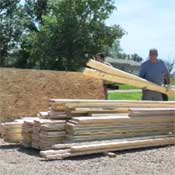The smell of fresh sawdust on a crisp fall morning, the slap and ring of hammers on boards, the sturdy feel of new framing – what’s not to love?
So it’s no surprise when builders set out to frame a pole building, sometimes they use a little more lumber than really needed. Sometimes a lot more. Saving lumber is not at the top of their minds. But wood isn’t free, or even cheap. It has a cost in dollars, in forested acres logged, and in natural ecosystems disrupted. And there’s a labor cost: more sticks to handle, more cuts to make, and more nails to pound.
 All things being equal, economizing on framing lumber makes a lot of sense. For builders willing to learn, there are proven ways to cut back on unnecessary framing lumber use, without compromising structural strength—and while saving energy.
All things being equal, economizing on framing lumber makes a lot of sense. For builders willing to learn, there are proven ways to cut back on unnecessary framing lumber use, without compromising structural strength—and while saving energy.
At Hansen Pole Buildings, we’ve fine-tuned our building shells for saving lumber and energy.
By utilizing value engineering, buildings are optimized to utilize the most efficient spacings and sizes of materials. Standardizing framing practices is a continuing challenge, as introducing new, unfamiliar methods adds yet another twist. As we’ve improved our overall pole building structural design, builders have had to retrain labor forces in the modified methods.
Most beginning pole builders learn the same simple routine on the job: wall girts and roof purlins 24 inches on center, often with doubled or tripled 2x12s for truss carriers. The bigger the header, the more supports beneath and when in doubt, “one more won’t hurt”. Or at least that seems to be the way it’s been done.
Advanced framing takes a little more thought and some relearning—and good drawings are important, too.
Continuous load paths make the best use of load-bearing materials. Advanced pole building framing is more than a set of details—it’s a system. In its fullest form, the system applies engineering to every element of the frame. The key is a continuous load path from roof trusses aligned to wall columns for direct transfer of roof loads to the ground.
A further refinement is to locate windows or doors to avoid evenly spaced wall columns. With steel siding, openings on a wall spaced at a multiple of 3’ from the same corner saves both materials and labor.
Less wood in the building means more money in the bank for building owners. Fewer pieces to install, means lower labor costs as well. Less wood also means fewer chances to make mistakes. Coming from a frugal Norwegian background, I was raised to always be thinking of how to “do more with less”. And when it comes to designing buildings, it just makes sense all around.






